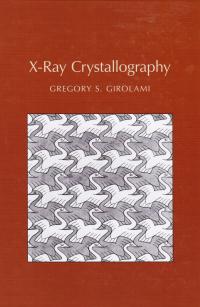X-Ray Crystallography
X-Ray Crystallography
By: Gregory S. Girolami
Featuring excellent illustrations and homework problems throughout, the book is intended both for advanced undergraduate and graduate students who are learning the subject for the first time, as well as for those who have practical experience but seek a text summarizing the theory of diffraction and X-ray crystallography.
For all sales outside of the United States, please contact Felicity Henson, fhenson@aip.org
Title information
X-Ray Crystallography is a well-balanced, thorough, and clearly written introduction to the most important and widely practiced technique to determine the arrangement of atoms in molecules and solids. Featuring excellent illustrations and homework problems throughout, the book is intended both for advanced undergraduate and graduate students who are learning the subject for the first time, as well as for those who have practical experience but seek a text summarizing the theory of diffraction and X-ray crystallography. It is organized into three parts: Part 1 deals with symmetry and space groups, Part 2 explains the physics of X rays and diffraction, and Part 3 examines the methods for solving and refining crystal structures. The discussion proceeds in a logical and clear fashion from the fundamentals through to advanced topics such as disorder, twinning, microfocus sources, low energy electron diffraction, charge flipping, protein crystallography, the maximum likelihood method of refinement, and powder, neutron, and electron diffraction. The author’s clear writing style and distinctive approach is well suited for chemists, biologists, materials scientists, physicists, and scientists from related disciplines. A detailed Instructor’s Manual is available for adopting professors.
Preface and Acknowledgments
SECTION 1. Symmetry and Space Groups
Chapter 1. Introduction
Chapter 2. Point Symmetry Operations
Chapter 3. Point Groups
Chapter 4. Periodicity
Chapter 5. Travel Symmetry Operations
Chapter 6. Two-dimensional Lattices
Chapter 7. Three-dimensional Lattices
Chapter 8. Two-dimensional Plane Groups
Chapter 9. Equivalent Positions
Chapter 10. Three-dimensional Space Groups, Part 1
Chapter 11. Three-dimensional Space Groups, Part 2
Chapter 12. Three-dimensional Space Groups, Part 3
SECTION 2. X-rays and Diffraction
Chapter 13. Generation of X-rays
Chapter 14. Diffractometers and Data Collection
Chapter 15. Data Reduction
Chapter 16. Scattering from a Single Electron
Chapter 17. Scattering from Atoms
Chapter 18. Diffraction from One-dimensional Arrays
Chapter 19. Diffraction from Two- and Three-dimensional Arrays
Chapter 20. Reciprocal Space and Reflection Indices
Chapter 21. Bragg’s Law, Scattering Planes, and d-Spacings
Chapter 22. The Limiting Sphere, Resolution, and Indexing
Chapter 23. Structure Factors and Argand Diagrams
Chapter 24. Phases, Friedel’s Law, and Laue Classes
Chapter 25. Centrosymmetry and Chirality
Chapter 26. Reflection Conditions
Chapter 27. Determining the Space Group of a Crystal
SECTION 3. Solving and Refining Crystal Structures
Chapter 28. Fourier Transforms in Crystallography
Chapter 29. Trial-and-error Methods
Chapter 30. Charge Flipping
Chapter 31. The Patterson Method
Chapter 32. The Heavy Atom Approximation
Chapter 33. Protein Crystal Structures
Chapter 34. Direct Methods, Part 1
Chapter 35. Direct Methods, Part 2
Chapter 36. Modeling the Electron Density
Chapter 37. Refining Crystal Structures
Chapter 38. Twinning
Chapter 39. Examples of Twinned Crystals
Chapter 40. Mistakes and Pitfalls
Chapter 41. Powder X-ray Diffraction
Chapter 42. Electron and Neutron Diffraction
Appendix A. Vector Tutorial
Appendix B. Complex Number Tutorial
Appendix C. The Ewald Sphere
Appendix D. Atomic Form Factors
Appendix E. The Patterson Function
Appendix F. In-class Demonstration of Diffraction
|
“X-Ray Crystallography is a textbook with a wide wingspan…perhaps one of the best textbooks addressing a readership of chemists published in recent years.” “I wish to congratulate the author on an excellent book, this is something that has been sorely missed. I have used several books over the years, but this one has exactly the right level, and the exercises are very useful as well.” “This is a very readable text, and generally very well written with good coverage and many excellent exercises. I particularly liked the chapters on symmetry and direct methods.” “Girolami, an expert in the area, understands key issues of crystallography from the standpoint of a practicing chemist. He communicates in a crisp style. I found his presentation of the topic to be clear and interesting, and would use this text as part of a course in chemical crystallography for advanced undergrads and beginning grad students.” “This text is very comprehensive, giving history, the never-changing basics of symmetry and diffraction, but also modern insights into synchrotron techniques etc. The number of illustrations and examples is wonderful, and I very much appreciate that this book does not shy away from the vector math necessary to show the properties of scattering and reciprocal space!” |

